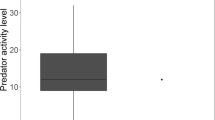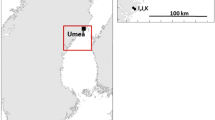Abstract
Intra-population variation in behaviour unrelated to sex, size or age exists in a variety of species. The mechanisms behind behavioural diversification have only been partly understood, but density-dependent resource availability may play a crucial role. To explore the potential coexistence of different behavioural types within a natural fish population, we conducted a radio telemetry study, measuring habitat use and swimming activity patterns of pike (Esox lucius), a sit-and-wait predatory fish. Three behavioural types co-occurred in the study lake. While two types of fish only selected vegetated littoral habitats, the third type opportunistically used all habitats and increased its pelagic occurrence in response to decreasing resource biomasses. There were no differences in size, age or lifetime growth between the three behavioural types. However, habitat-opportunistic pike were substantially more active than the other two behavioural types, which is energetically costly. The identical growth rates exhibited by all behavioural types indicate that these higher activity costs of opportunistic behaviour were compensated for by increased prey consumption in the less favourable pelagic habitat resulting in approximately equal fitness of all pike groups. We conclude that behavioural diversification in habitat use and activity reduces intraspecific competition in preferred littoral habitats. This may facilitate the emergence of an ideal free distribution of pike along resource gradients.






Similar content being viewed by others
References
Andersen M, Jacobsen L, Gronkjaer P, Skov C (2008) Turbidity increases behavioural diversity in northern pike, Esox lucius L., during early summer. Fish Manage Ecol 15:377–383
Bell AM (2007) Future directions in behavioural syndromes research. Proc R Soc Lond B Biol Sci 274:755–761
Boisclair D, Sirois P (1993) Testing assumptions of fish bioenergetics models by direct estimation of growth, consumption, and activity rates. Trans Am Fish Soc 122:784–796
Bolnick DI (2001) Intraspecific competition favours niche width expansion in Drosophila melanogaster. Nature 410:463–466
Bolnick DI, Svanbäck R, Fordyce JA, Yang LH, Davis JM, Husley CD, Forister ML (2003) The ecology of individuals: incidence and implications of individual specialization. Am Nat 161:1–28
Brown JS (1996) Coevolution and community organization in three habitats. Oikos 75:193–206
Casselman JM (1974) External sex determination of northern pike, Esox lucius Linnaeus. Trans Am Fish Soc 103:343–347
Davies NB (1977) Prey selection and search strategy of spotted flycatcher (Muscicapa striata): a field study on optimal foraging. Anim Behav 25:1016–1037
De Kerckhove D, McLaughlin RL, Noakes DLG (2006) Ecological mechanisms favouring behavioural diversification in the absence of morphological diversification: a theoretical examination using brook charr (Salvelinus fontinalis). J Anim Ecol 75:506–517
Ehlinger TJ, Wilson DS (1988) Complex foraging polymorphism in bluegill sunfish. Proc Natl Acad Sci USA 85:1878–1882
Eklöv P, Diehl S (1994) Piscivore efficiency and refuging prey: the importance of predator search mode. Oecologia 98:344–353
Francis RICC (1990) Back calculation of fish length: a critical review. J Fish Biol 36:883–902
Fredrich F, Ohmann S, Curio B, Kirschbaum F (2003) Spawning migrations of the chub in the river Spree, Germany. J Fish Biol 63:710–723
Fretwell SD, Lucas HL (1970) On territorial behavior and other factors influencing habitat distribution in birds. Acta Biotheor 19:16–36
Gallucci VF, Quinn TJ (1979) Reparameterizing, fitting, and testing a simple growth model. Trans Am Fish Soc 108:14–25
Grimm MP, Klinge M (1996) Pike and some aspects of its dependence on vegetation. In: Craig JF (ed) Pike biology and exploitation. Chapman & Hall, London, pp 125–156
Hanson PC, Johnson TB, Schindler DE, Kitchell JF (1997) Fish bioenergetics 3.0 for Windows. University of Wisconsin Sea Grant Institute, Madison
Harper DG, Blake RW (1991) Prey capture and the fast-start performance of northern pike Esox lucius. J Exp Biol 155:175–192
Haugen TO, Winfield IJ, Vollestad LA, Fletcher JM, James JB, Stenseth NC (2006) The ideal free pike: 50 years of fitness-maximizing dispersal in Windermere. Proc R Soc Lond B Biol Sci 273:2917–2924
Helfman GS (1993) Fish behaviour by day, night and twilight. In: Pitcher TJ (ed) Behaviour of teleost fishes. Chapman & Hall, London, pp 479–512
Hölker F, Breckling B (2002) Influence of activity in a heterogeneous environment on the dynamics of fish growth: an individual-based model of roach. J Fish Biol 60:1170–1189
Hölker F, Mehner T (2005) Simulation of trait-mediated and density-mediated indirect effects of piscivorous predators on a lake food web. Basic Appl Ecol 6:289–300
Hölker F, Dörner H, Schulze T, Haertel-Borer SS, Peacor S, Mehner T (2007) Species-specific responses of planktivorous fish to the introduction of a new piscivore: implications for prey fitness. Freshwater Biol 52:1793–1806
Inoue T, Matsura T (1983) Foraging strategy of a mantid, Paratenodera angustipennis S.: mechanisms of switching tactics between ambush and active search. Oecologia 56:264–271
Jepsen N, Beck S, Skov C, Koed A (2001) Behavior of pike (Esox lucius L.) >50 cm in a turbid reservoir and in a clearwater lake. Ecol Freshwater Fish 10:26–34
Jepsen N, Koed A, Thorstad EB, Baras E (2002) Surgical implantation of telemetry transmitters in fish: how much have we learned? Hydrobiologia 483:239–248
Klefoth T (2007) Behaviour of pike (Esox lucius L.) in response to angler-induced disturbance in a catch-and-release fishery in Lake Kleiner Döllnsee. Humboldt-Universität zu Berlin, Faculty of Agriculture and Horticulture. http://www.adaptfish.rem.sfu.ca/Thesis_MSc_Klefoth.pdf
Klefoth T, Kobler A, Arlinghaus R (2008) The impact of catch-and-release angling on short-term behaviour and habitat choice of northern pike (Esox lucius L.). Hydrobiologia 601:99–110
Knight CM, Gozlan RE, Lucas MC (2008) Can seasonal home-range size in pike Esox lucius predict excursion distance? J Fish Biol 73:1058–1064
Kobler A (2007) Habitatwahl und Aktivität des Hechtes (Esox lucius L.) im Kleinen Döllnsee: Eine radiotelemetrische Untersuchung. Universität Hohenheim, Fakultät für Agrarbiologie. http://www.adaptfish.rem.sfu.ca/Thesis_Diplomarbeit_Kobler.pdf
Kobler A, Klefoth T, Arlinghaus R (2008a) Site fidelity and seasonal changes in activity centre size of female pike Esox lucius in a small lake. J Fish Biol 73:584–596
Kobler A, Klefoth T, Wolter C, Fredrich F, Arlinghaus R (2008b) Contrasting pike (Esox lucius L.) movement and habitat choice between summer and winter in a small lake. Hydrobiologia 601:17–27
Lewis KP (2006) Statistical power, sample sizes, and the software to calculate them easily. Bioscience 56:607–612
Lucas MC, Johnstone ADF, Priede IG (1993) Use of physiological telemetry as a method of estimating metabolism of fish in the natural environment. Trans Am Fish Soc 122:822–833
MacArthur RH, Levins R (1964) Competition, habitat selection, and character displacement in a patchy environment. Proc Natl Acad Sci USA 51:1207–1210
Masters JEG, Hodder KH, Beaumont WRC, Gozlan RE, Pinder AC, Kenward RE, Welton JS (2005) Spatial behaviour of pike Esox lucius L. in the River Frome, UK. In: Spedicato MT, Lembo G, Marmulla G (eds) Aquatic telemetry: advances and applications. Proceedings of the Fifth Conference on Fish Telemetry held in Europe, Ustica, Italy, 9–13 June 2003. FAO/COISPA, Rome, pp 179–190
McCune B, Mefford MM (1999) PC-ORD—multivariate analysis of ecological data. MjM Software Design, Gleneden Beach
Morbey YE, Addison P, Shuter BJ, Vascotto K (2006) Within-population heterogeneity of habitat use by lake trout Salvelinus namaycush. J Fish Biol 69:1675–1696
Morris DW (1996) Coexistence of specialist and generalist rodents via habitat selection. Ecology 77:2352–2364
Morris DW (2003) Toward an ecological synthesis: a case for habitat selection. Oecologia 136:1–13
Nilsson PA (2006) Avoid your neighbours: size-determined spatial distribution patterns among northern pike individuals. Oikos 113:251–258
Nilsson PA, Brönmark C (1999) Foraging among cannibals and kleptoparasites: effects of prey size on pike behavior. Behav Ecol 10:557–566
Nilsson PA, Brönmark C (2000) Prey vulnerability to a gape-size limited predator: behavioural and morphological impacts on northern pike piscivory. Oikos 88:539–546
Norberg RA (1977) Ecological theory on foraging time and energetics and choice of optimal food-searching method. J Anim Ecol 46:511–529
Okun N, Mehner T (2005) Distribution and feeding of juvenile fish on invertebrates in littoral reed (Phragmites) stands. Ecol Freshwater Fish 14:139–149
Pàlsson OK, Thorsteinsson V (2003) Migration patterns, ambient temperature, and growth of Icelandic cod (Gadus morhua): evidence from storage tag data. Can J Fish Aquat Sci 60:1409–1423
Persson L, Bertolo A, de Roos AM (2006) Temporal stability in size distributions and growth rates of three Esox lucius L. populations. A result of cannibalism? J Fish Biol 69:461–472
Raat AJP (1988) Synopsis of biological data on the northern pike Esox lucius Linnaeus, 1758. Food and Agriculture Organization of the United Nations, Rome
Réale D, Reader SM, Sol D, McDougall PT, Dingemanse NJ (2007) Integrating animal temperament within ecology and evolution. Biol Rev 82:291–318
Rogers KB (1998) Habitat use by largemouth bass and northern pike on the Rocky Mountain Arsenal, Colorado. Colorado State University, Fort Collins
Rogers KB (2002) FishTel: telemetry analysis package, version 1.4. Colorado Division of Wildlife, Denver
Rogers KB, White GC (2007) Analysis of movement and habitat use from telemetry data. In: Guy CS, Brown ML (eds) Analysis and interpretation of freshwater fisheries data. American Fisheries Society, Bethesda
Rosenzweig ML (1991) Habitat selection and population interactions: the search for mechanism. Am Nat 137:S5–S28
Schreckenbach K, Knösche R, Ebert K (2001) Nutrient and energy content of freshwater fishes. J Appl Ichthyol 17:142–144
Sih A, Bell A, Johnson JC (2004) Behavioural syndromes: an ecological and evolutionary overview. Trends Ecol Evol 19:372–378
Svanbäck R, Bolnick DI (2007) Intraspecific competition drives increased resource use diversity within a natural population. Proc R Soc Lond B Biol Sci 274:839–844
Svanbäck R, Persson L (2004) Individual diet specialization, niche width and population dynamics: implications for trophic polymorphisms. J Anim Ecol 73:973–982
Svanbäck R, Eklöv P, Fransson R, Holmgren K (2008) Intraspecific competition drives multiple species resource polymorphism in fish communities. Oikos 117:114–124
Swanson BO, Gibb AC, Marks JC, Hendrickson DA (2003) Trophic polymorphism and behavioral differences decrease intraspecific competition in a cichlid, Herichthys minckleyi. Ecology 84:1441–1446
Turesson H, Brönmark C (2007) Predator–prey encounter rates in freshwater piscivores: effects of prey density and water transparency. Oecologia 153:281–290
Vehanen T, Hyvärinen P, Johansson K, Laaksonen T (2006) Patterns of movement of adult northern pike (Esox lucius L.) in a regulated river. Ecol Freshwater Fish 15:154–160
Vøllestad LA, Skurdal J, Qvenild T (1986) Habitat use, growth, and feeding of pike (Esox lucius L.) in 4 Norwegian lakes. Arch Hydrobiol 108:107–117
von Bertalanffy L (1938) A quantitative theory of organic growth. Hum Biol 10:181–213
Werner EE, Hall DJ (1976) Niche shifts in sunfishes: experimental evidence and significance. Science 191:404–406
Winberg GG (1956) Rate of metabolism and food requirements of fishes. Belorussian University, Minsk
Wolf M, van Doorn GS, Weissing FJ (2008) Evolutionary emergence of responsive and unresponsive personalities. Proc Natl Acad Sci USA 14:15825–15830
Wysujack K, Mehner T (2002) Comparison of losses of planktivorous fish by predation and seine-fishing in a lake undergoing long-term biomanipulation. Freshwater Biol 47:2425–2434
Acknowledgments
We thank Alexander Türck, Michael Fritsch, Dieter Opitz, Christian Helms, Thomas Hintze, Christian Wolter, Frank Fredrich, Volker Huckstorf and Christian Lewin for technical assistance, experimental set up and helpful discussions. Thanks also to Ian Winfield, Thrond Haugen, Richard Svanbäck, Anders Nilsson and the handling editor Libby Marschall for helpful reviews and comments on the manuscript. This study was partly funded by the R + D project Inland Fisheries Management at the Leibniz Institute of Freshwater Ecology and Inland Fisheries and the Adaptfish-Project funded by the Leibniz Community through a grant to R. A. (www.adaptfish.igb-berlin.de). This study was approved through an animal care permit granted by the Ministry for Rural Development, Environment and Consumer Protection, Brandenburg, according to the German Animal Protection Act.
Author information
Authors and Affiliations
Corresponding author
Additional information
Communicated by Libby Marschall.
Electronic supplementary material
Below is the link to the ESM.
Rights and permissions
About this article
Cite this article
Kobler, A., Klefoth, T., Mehner, T. et al. Coexistence of behavioural types in an aquatic top predator: a response to resource limitation?. Oecologia 161, 837–847 (2009). https://doi.org/10.1007/s00442-009-1415-9
Received:
Accepted:
Published:
Issue Date:
DOI: https://doi.org/10.1007/s00442-009-1415-9




